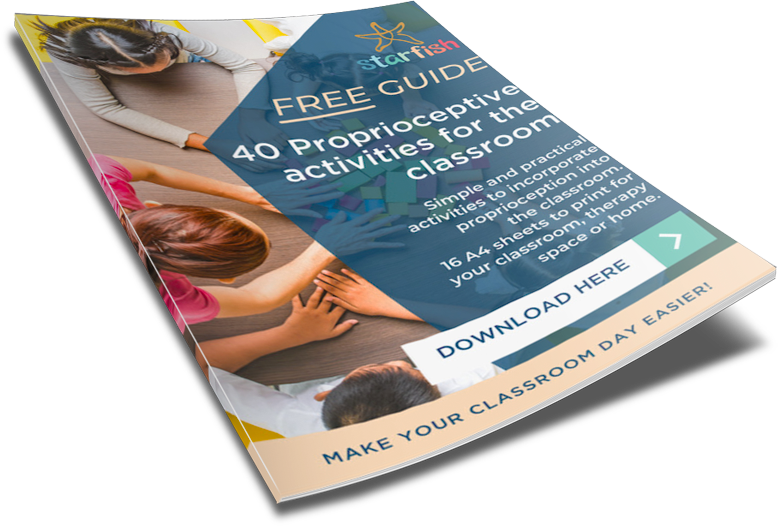Your Cart is Empty
NDIS Approved Provider | Trusted by 200+ industry professionals | 25 years of expert knowledge & Experience

Here at Starfish, we often say synthetic phonics is the bread & butter of our reading program.
Phonics is the Bread, blending is the Butter.
Blending is what we need to be doing as part of synthetic phonics, it is superimportant.
It's the skill of blending that helps us read, especially when confronted with words we don't know. Young children know far fewer words so they will need to blend many of the new words they discover. It involves pushing together the sounds of the letters in the word in order to create the whole word. For example, a child trying to read the word ‘fish’, will isolate each of the letter sounds. When these three sounds are said in sequence, the word ‘fish’ is spoken.
First, have a look at this fab video podcast from literacy expert Associate Professor Dr Deslea Konza, then have a read on...

Phonics is a way we can teach children to read and write. Phonics is the visual representation of the sounds in our language in written language. A bit like when you look in the dictionary, it breaks a word down into hyphenated sounds to explain 'how' to say it
Basically, phonics is a code. A visual/written code for the sounds in our spoken words. For example, the sound k can be spelled as c, k, ck or ch.
This is why we call reading ‘decoding’ (converting the print into their sounds) and writing/spelling is ‘encoding’ (turning the sounds into the print).
Of course reading is more than just decoding and spelling is more than just encoding, but they are vital and a HUGE part of each other.
If you want to read more, the National Literacy Trust have heaps of great info and articles on phonics. Click here to explore their website!

Over many many years our English language has developed and evolved.
English has ‘taken’ words from other languages and ended up with 44 different sounds (PHONEMES), in our English spoken language.
Each visual representation of those sounds is referred to as a GRAPHEME.
The big problem is, however, is that we only have 26 letters of the alphabet to map those sounds.
No matter how hard you try, 44 doesn’t equal 26.We simply don’t have enough letters in our alphabet to have one letter for every sound.

So, we use letter combinations to make up the shortfall. We also have ended up somehow with more than one way to code or represent a sound.
There are fairly simple ones such as “ch” as in chop, “sh” as in shop and “th” as in this. There are more complex graphemes such as “ay” as in play, “ee” as in tree and “ar” as in car.
Then there are letter combinations. Like “tion” as in station and “ous” as in enormous.

Here are a couple of grapheme examples...
'ai'and 'ay' - Two different ways of getting the long vowel 'a' sound. Like in the words 'rain' and 'today'.
One common way of getting the long vowel 'i' sound, like in the words 'night'or 'light'.
Even some of the individual letters of the alphabet have multiple sounds. Just check out our example of the letter "Y" here!
Weird, I know. Unfortunate, I know. But, it is what it is and we best get on with the teaching!
One thing we do know is that most children, certainly struggling readers, need to be taught phonics explicitly and systematically...
From the 26 letters of the alphabet and the sound(s) each letter makes to the various graphemes and letter combinations, introducing young children to the joy and wonder of books requires a systematic teaching of phonics.
In the early years, children will be listening to sounds in the world around them, and copying the sounds (e.g. ‘can you make a car sound? What sound does a dog make?’)
Try these...
As your child gets into their first year of school they will learn a lot of phonics fast! Here are some ways to keep encourage this...
And as they progress further...

Just remember...
So what is phonics? It is the relationship between sounds and their spellings. The building blocks of the spoken English language. Some are easy, some are complex, and they will all take varying levels of time to master.
It’s the code, and it needs to be taught explicitly and systematically.
The more easily they can hear, identify, and manipulate sounds, the easier it will be for them to decode new words when they are ready to read.
If you have any questions particular to phonics, as always, please let us know! We'll try and include responses into future blogs or even contact you directly.
Similarly, if you have any great ways of your own to share with the Starfish community, please please do!
Love team Starfish x

40 Proprioceptive activities for the classroom. Simple and practical activities to incorporate Proprioceptive into the classroom. 16 A4 sheets to print for your classroom, therapy space or home.